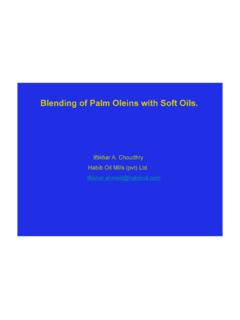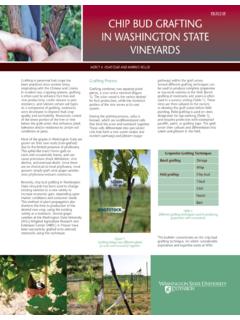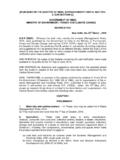Transcription of PHILIPPINE PALM OIL INDUSTRY ROAD MAP
1 PHILIPPINE PALM OIL INDUSTRY road MAP 2014- 2023 Dr. Pons Batugal Director , Governing Board PHILIPPINE Coconut Authority 55000 50000 45000 40000 35000 30000 HECTARES 2008 2009 2010 2011 2012 Y E A R Oil Palm Production Area (has), Philippines, 2008-2012 PRODUCTION STATISTICS Year 2012 total area 56,641 ha Production at average rate of annually Biggest expansion area: Caraga Region - 35% of prod. area SOCSKSRAGEN - 30% of prod. area OIL MILLS Philippines has 8 existing palm oil mills with a total rated capacity of 265 metric tons FFB per hour, owned by six companies 1)Agumil Phil Inc. (AGPI), 2) PALM Inc., 3) A. Brown Energy Resources Devt. (ABERDI), 4) Kenram Industrial and Development, Inc. (KIDI), and 5) Filipinas Palm Oil Plantation, Inc.
2 6)Univanich Carmen Palm Oil Mill _____ With the total of 265 MT per hour capacity, the country is capable of producing 1,559,910 MT of palm oil per year. If fully utilized, this production capacity requires a total of 86,660 hectares of oil palm plantation. SUPPLY Local Supply 40,000 MT crude palm oil 3,000 MT palm kernel oil Entirely consumed in the domestic market Imports - Yr 2010: 225,000 MT valued at PhP Yr 2012: 500,000 MT valued at PhP 17B Yr 2022: Projected import : PhP 22 -27B (Yr 2010) Oil Palm Nurseries 12 registered oil palm nurseries are operating in the country as of December 2012. Most of these nurseries are owned by big plantation companies located in Region 12 and Caraga region These companies have imported oil palm pre-germinated seeds/seedlings from Papua New Guinea, Thailand and Costa Rica.
3 POTENTIAL PRODUCTION AREAS MORE THAN 1 Million HECTARES 98% located in Mindanao particularly in Caraga region ( 39% ) Emerging area is in Palawan with prospective area of 100,000 hectares Strength, Weaknesses, Opportunities and Threats of Oil Palm INDUSTRY STRENGTH of Oil Palm INDUSTRY Wide potential area for oil palm production Availability of production technologies and best practices that can be adopted Available technical expertise in the government and private sector Presence of research centers & academic institutions capable of conducting researches on oil plam Availability of low-cost labor for oil palm farm activities Existence of Palm Oil mills Out-growership scheme of plantation and mill owners WEAKNESSES OPPORTUNITIES THREATS Lack of comprehensive suitability assessment of existing and potential areas Favourable climatic condition Unstable peace and order conditions in some areas Lack of tenurial instruments High investment cost Total dependence on imported planting materials High cost of planting materials Access
4 To imported seeds from Thailand, Indonesia, Malaysia, Latin America PCA s available technology to produce hybrid planting materials Existence of unaccredited F1/F2 nurseries Inadequate road network especially in the rural areas and small growers location Coordination/linkage with the LGUs, MRDP/PRDP, other government agencies Oil millers plans to rehabilitate or maintain road network WEAKNESSES OPPORTUNITIES THREATS Lack of information and education campaign Access to plantations that have the best technologies and practices Willingness of private sector to share their technical expertise Negative publicity of oil palm farming in the environment Breeding program in Mindanao at USM, PCA and ASSCAT Production of planting materials thru tissue culture Research studies on oil palm has limited budget allocation Job generation Existence of Palm Oil mills High transportation cost of FFB from farm to mills Great distance of the mills from the farms WEAKNESSES OPPORTUNITIES THREATS Fragmented production areas Organization/consolida-tion of small landowners for economies of scale Postharvest losses Lack of technologies on food and non-food bio-mass utilization PHILIPPINE PALM OIL INDUSTRY DEVELOPMENT VISION, MISSION, OBJECTIVES Vision A dynamic, innovative and self-sufficient INDUSTRY that complements the PHILIPPINE Coconut INDUSTRY and provides benefits to various stakeholders, and have enough vegetable oils for the country, and for export.
5 Mission To develop the Oil Palm INDUSTRY through gainful production, processing and marketing of oil palm products and by-products to ensure food security, increased income and rural employment through good agricultural and manufacturing practices and sustainable oil palm development. Objectives To meet the country s palm oil domestic requirements, develop the countryside and provide employment to rural communities. SPECIFIC OBJECTIVES To increase yield, productivity through cost efficient technologies. To use under-productive and idle areas with a sustainable environment program so that by 2023 , a total of about 353,000 hectares shall have been planted to oil palm. To increase milling capacity from 235 MT/hr to 1,590 MT/hr which entails the establishment of 79 milling plants each w/ a cap. of 20 MT/hr or bigger capacity mills by 2023 . To increase the number of palm oil refineries as may be necessary. SPECIFIC OBJECTIVES To generate employment and enhance livelihood activities in the countryside so that by the end of 2023 , a total of about 300,000 farmers shall have benefited from INDUSTRY development.
6 To identify the provinces, municipalities and barangays where oil palm planting shall be expanded to guide the planners and builders of farm-to-market roads and research and training facilities. To encourage and provide incentives to local or foreign investors to provide their rural oil palm-growing communities with basic amenities such as housing, health facilities, schools and recreational centers in all Oil Palm regions. INDUSTRY DEVELOPMENT STRATEGIES Strategies grouped into: PRODUCTIVITY ENHANCEMENT INVESTMENT MARKET DEVELOPMENT BUSINESS ENABLING Productivity Enhancement Strategy Area of Concern Strategy areas for oil palm production Oil Palm Suitability Assessment thru GIS mapping Conduct of regular land-banking activities to oil palm regions to identify/process/profile the potential production areas 2. Planting materials Accreditation of private oil palm nurseries Strict implementation of quarantine and certification rules and regulations Production of hybrids from existing palms using DNA markers Production of planting materials thru tissue culture Implementation of Plant Now Pay Later scheme for planting materials and farm inputs Productivity Enhancement Strategy Area of Concern Strategy 3.
7 Plantation road network Construction/rehabilitation of farm to market and secondary roads Adoption of mechanization, agricultural tramline 4. Limited awareness on best production practices and technologies Capacity enhancement and capability building for farmers and extension workers Production of IEC materials for farmers/out-growers Conduct of farm-based researches through government-private-academe partnerships Establishment and maintenance of Oil Palm website Productivity Enhancement Strategy Area of Concern Strategy 5. Postharvest operations Provision of hauling equipment as shared service facilities to the organized oil palm growers Establishment of new mills and processing facilities in strategic locations Research on the use of oil palm food and non-food biomass in small holders farms and plantations 6. Out-growership scheme Review of out-growership scheme by the government to determine weaknesses and recommend improvements Investment Strategy Area of Concern Strategy 1.
8 Investment Promotion campaign Establishment of INDUSTRY website for investment promotion Publication of investment brochures/profiles/ briefs for Oil palm development projects Conduct Palm Oil Congress/Summit 2. Land banking/ profiling activities Conduct regular land banking activities to identify/ process/profile the potential production areas Publication of area profile of ancestral domain/CADT / ARC for investment promotion Conduct of forum on Tenurial Issues in to identify policy issues that hinders the devt. of CADT and logged-over areas Lobby for the revision of EO 23 to pursue agricultural plantation development for CADT and former logging concession areas Market Development Strategy Area of Concern Strategy 1. Price Meeting among outgrower representative, oil millers and concerned government agencies regarding the prices offered to the outgrowers 2.
9 Market/trading information Market research, organize and strengthen farmers, processors, traders organizations- INDUSTRY cluster/value chain approach Agri and market information system and info dissemination Public-private participation (farmers & processing firms) on trading supply transactions 3. Entrepreneurship Conduct of capability building training on entrepreneurship/enterprise development Business Enabling Strategy Area of Concern Strategy 1. High interest rates of financing institutions Promoting access to capital especially for smallholders through special financing windows for planting/replanting Credit services for collective purchases of farm inputs 2. Sustainable and regular financing for the INDUSTRY development A special law that will allow the government to collect from millers some amount from their sale of palm oil and other future OP products to fund programs and projects for the development of the INDUSTRY Meetings with DTI-BOI to secure incentives and with financial institutions to source domestic funding and NEDA for external financing Proposed Programs, Activities and Projects for the Palm Oil INDUSTRY , 2014- 2023 Program/ Activities/ Projects Concept/Description Output 1.
10 Establishment of Database of Oil Palm INDUSTRY This aims to have an organized mechanism for storing, managing and retrieving facts and figures which will provide inputs for analysis, forecasting and over-all strategic programming of the oil palm INDUSTRY . Oil palm INDUSTRY Database Oil Palm website (FAQ, investment, market information) 2. Oil Palm Suitability Assessment Suitability mapping on proposed potential areas for oil palm production thru GIS mapping to know the actual location, topography, slope, etc. of the area; to evaluate the proposed area its ownership, land classification, crops planted, etc. Suitability map Profile of the proposed area Proposed Programs, Activities and Projects for the Palm Oil INDUSTRY , 2014- 2023 Program/ Activities/ Projects Concept/Description Output of Plant Now Pay Later scheme for the provision of planting materials and farm inputs to contract growers This project will address the high cost of planting materials and fertilizers in oil palm plantation.




